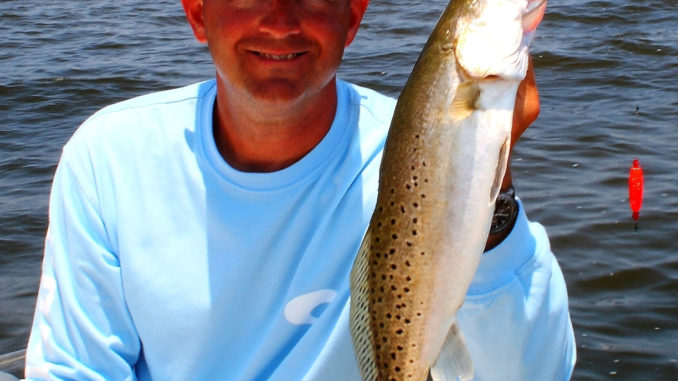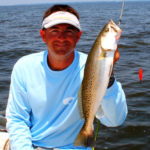
Sliding floats allow for great fishing versatility
I’m really not thinking about that song by the Beach Boys, but the catches that come from fishing a bobber-stopper rig can be enough to make you want to sing. If you have enough tackle to dedicate one outfit specifically for float fishing, a bobber-stopper rig is the way to go. It allows you to fish shallow or deep without re-tying, and it only takes a few seconds to adjust the depth.
I’m surprised at times when saltwater fishermen don’t immediately recognize what I am talking about when I mention a bobber-stopper rig. I know bobber-stoppers came from freshwater fishing, but I have to admit that since I discovered them, I use them a lot.
Bobber-stoppers are devices used to adjust and limit the travel of a cork. They allow a cork to slide down the line so it can be cast easily and then stop the cork at the desired depth as it slides back up the line. This makes a world of difference when fishing deep enough that a fixed cork hinders casting.
The first bobber-stopper rigs were light freshwater versions; the cork slid down the line to the split-shot just above the hook for casting. Once the cork landed, the split shot pulled the line through the cork until it slipped back up the line to the bobber stopper and stopped the bait at the right depth.
Bobber-stoppers have become a “must-have” item in my tackle box. My introduction to bobber stoppers was to position corks, and I believe that was their original purpose, but I have found them to be a great way to locate just about anything on fishing line. I have used them to make popping and rattling corks, to limit the travel of a sinker on a Carolina rig, hold king mackerel skirts in place just in front of the bait, position the skirts on multiple lure Spanish mackerel rigs and more.
The first bobber-stoppers I used were pieces of heavier string — I think cotton string — that were tied around the fishing line, and a small plastic bead. The string would stop the bead, and the bead would stop the cork. Because the string knot was tied around the fishing line, you could move it up and down the fishing line.
The first ones I saw in tackle stores had a knot pre-tied around a small piece of tubing or a straw. You slid the straw up your line, eased the knot off and tightened it around your line and slid the straw off. Next, a bead was slipped on the line so it would slide up to the knot, then the cork was added and the rig completed with the terminal split shot and hook.
Differing varieties of bobber-stoppers have been made since then, and different people like different styles. The original ones bothered me a little as they got older and the ends of the line for the knot frayed. There were times these ends slapped and grabbed a little at the rod guides when casting and made a cast fall short or veer to the side.
About 20 years ago, I found some bobber-stoppers that are small pieces of rubber. These are on a holder that looks like a key fob and have a doubled wire running through them. The bobber stoppers are tapered on each end and look like miniature footballs. You insert your line through the loop at the end of the wire and use the wire to pull your line through the bobber-topper the first time. The rubber grabs your line, but is just loose enough you can slide it up and down your line. The rubber replaces the knot tied around your line and slides through guides much easier.
These rubber bobber-stoppers work very well on monofilament but will begin to creep after a while when used on some braided lines. Braided lines are a bit abrasive, and sliding the bobber stopper up and down to adjust depth will create wear in the hole, which gradually makes the hole larger to where the bobber-stopper slips. When it does, it’s a simple matter to replace the worn bobber-stopper.
After years of experimenting with bobber-stopper rigs, I have come up with what I believe is the ultimate arrangement for inshore fishing. It’s a little more complex and uses two rubber bobber stoppers, but I really like it and find it versatile.
My inshore rig uses one of the bobber- stoppers to create a sliding float for casting, just like any other bobber-stopper rig. When using it this way, the second bobber-stopper stays at the bottom, just above the swivel and out of the way. If you want to make this a popping or rattling cork rig, the second bobber-stopper can be used to position a popping and/or rattling cork anywhere on a line.
This rig begins by putting a bobber-stopper on the line coming from the reel and sliding it up a couple of feet. Next, slide two glass beads up the line and follow them with the float, with the cupped end towards the reel. I like the non-weighted, 5 inch Shur-Strike Glo-Top Popping Float from Sea Striker; it has ceramic-coated inserts at each end that don’t chafe the line sliding through them and resonate the sound of the beads clicking on them. The reason for using a non-weighted float is that if cast into water shallower than the depth is set, the cork will lay on its side and not turn upright, which lets fishermen know something isn’t right.
After the float, add a single glass bead, a 1/2-ounce egg sinker, another single glass bead and the second bobber-stopper, then tie a 30- or 40-pound swivel at the end of the line. The leader goes below this swivel and it is made of 12 to 24 inches of 15- or 20-pound low visibility monofilament or fluorocarbon. I like the Eagle Claw L042 Series wide-bend hook in No. 4 for trout and tripletail and Nos. 2 or 1 for puppy drum. The wide bend of the L042 hook makes it easy to attach a live bait.
When used as a standard bobber-stopper or sliding cork rig, the bobber-stopper lowest on the line is positioned just above the knot attaching the swivel. This stops the beads and egg sinker above the knot and prevents them chafing and weakening the knot. The top bobber-stopper is set at the fishing depth and stops the cork when it slides up the line after setting on the water. The sinker pulls the bait down to depth.
If using larger or stronger baits, a split-shot may be added a few inches above the hook to help hold the bait down.
This rig may also be used as a popping or rattle cork rig. As in the other rig, the top bobber-stopper is used to stop the cork and set the depth. Then, the lower bobber-stopper is moved up the line to limit the distance the cork can slide to 3 or 4 inches. With the rod tip lowered and a quick flip of the wrist, the popping cork will scoop water and pop. The top beads rattle when the sinker pulls the line down and the cork slides up.
If you have a rod and reel you can dedicate to a float rig, this is a way to make it work as both a slip cork, adjustable depth rig and a popping cork rig. Once you start using bobber-stoppers, I bet you’ll find other ways to use them too.






Be the first to comment